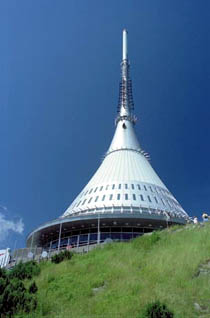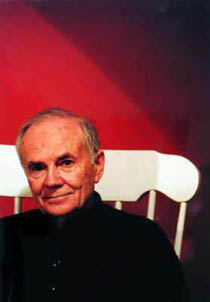
Pocta ČKA bude Karlu Hubáčkovi předána při zahájení výstavy
 |
The exhibition will have two parts:
1. In the exhibition hall, Ještěd will be presented multimedia (chief curator: photographer Jiří Jiroutek)
video screenings of films about Ještěd and its construction,
factual photographic documentation of the origin and history,
distant views of Ještěd on the hill,
detailed views of the building,
a model from Vítkovice (2.5 m high in the center of the room), possibly a smaller one from the Trade Fair Palace,
parts of the original interior equipment and dishes (in free space).
Catalog: already published publication "Phenomenon Ještěd" (author and publisher Jiří Jiroutek)
2. In the foyer, a selection of K. Hubáček's other buildings will be presented, including several portraits of him from different times (chief curator: Petr Kratochvíl)
about 10 exhibition panels are expected,
works that, alongside the transmitter at Ještěd, represent other peaks of Karel Hubáček's work will be highlighted, particularly the concert hall in Teplice (1986) and the DAMU theater in Prague (1994–99). Depending on the technical quality of the documentation, older realizations will also be selected, such as the cinema in Doksy (1967), K. Hubáček's own prefabricated house, technical structures of radio transmitters, and the water reservoir balancing tower in Prague, including interior designs and significant unrealized projects.
Catalog: It will include a shorter introductory text, biography, list of works, and bibliography. In the visual part, the buildings presented at the exhibition will also be supplemented with others in which K. Hubáček participated partially, or those whose photographic documentation cannot be exhibited in a large format due to technical reasons.
 |
Hubáček's close collaboration with outstanding engineers was crucial for the work of the SIAL studio, which he founded along with other architects in 1969 and led himself. (After being disbanded in the 1970s, it was revived in 1990, briefly again under his leadership.) Hubáček's other transmitters, which he built in Sudan and Yemen in the 1970s, as well as the balancing water tower in Prague at Dívčí Hrady (1972–77) and the meteorological tower in Prague-Libuš (1973–79, both with Z. Patrman), are also structurally inventive. However, the concert hall building in Teplice (1977–86, colonnade O. Binar) should be regarded as the second peak of Hubáček's work, a deliberately simply designed building, drawing particularly in the interior design from the requirements of acoustics. This realization also received international recognition: the Grand Prix at the Interarch biennale in Sofia in 1989. His last realization serving a cultural mission is also the extension and reconstruction of the DAMU building in Prague (1996–99, with J. Hakulín).
In addition to these key works, he is the author of several other realizations as their principal author – e.g. the Small Stage of the F. X. Šalda Theater (1986–89) and the Commercial Bank (1992–94) in Liberec – or as a collaborator with his colleagues: in the project for the Ještěd shopping center in Liberec (1968–71, chief author M. Masák) or in completing the Husa na provázku theater in Brno (1985–93, chief author V. Králíček).
Karel Hubáček, a man of sparkling spirit and broad cultural horizons, always excelled in the inventiveness of his designs and inflexibility in promoting true architecture even in times that were completely unfavorable to it. It is thanks to this that the work of the SIAL studio resonated beyond Czech borders and, as one of the few, was frequently published in foreign prestigious magazines even in the 1970s and 1980s. His personal renown and the example of Ještěd attracted many young architects to him in Liberec, to whom he provided an extraordinarily free and inspiring environment in his studio.
In the so-called SIAL Kindergarten, which he founded together with M. Masák in 1969, he nurtured several generations of architects who later significantly influenced the development of Czech architecture or made their mark abroad. He continued his educational impact even after 1989 at the newly established Faculty of Architecture in Liberec. For his work, Karel Hubáček received, in addition to the aforementioned awards, the award from the Society of Architects for lifetime achievement, the Herder Prize, and an honorary doctorate from ČVUT. The fact that the building on Ještěd was declared the Czech building of the 20th century in several polls is undoubtedly also an honor.
Photo: Petr Jedinák (www.jedinak.cz)
The English translation is powered by AI tool. Switch to Czech to view the original text source.
0 comments
add comment











